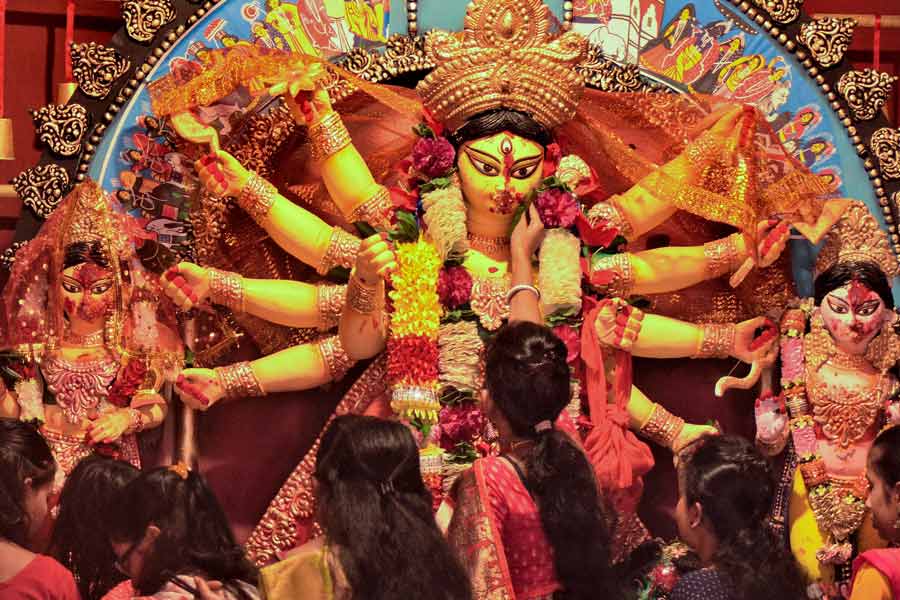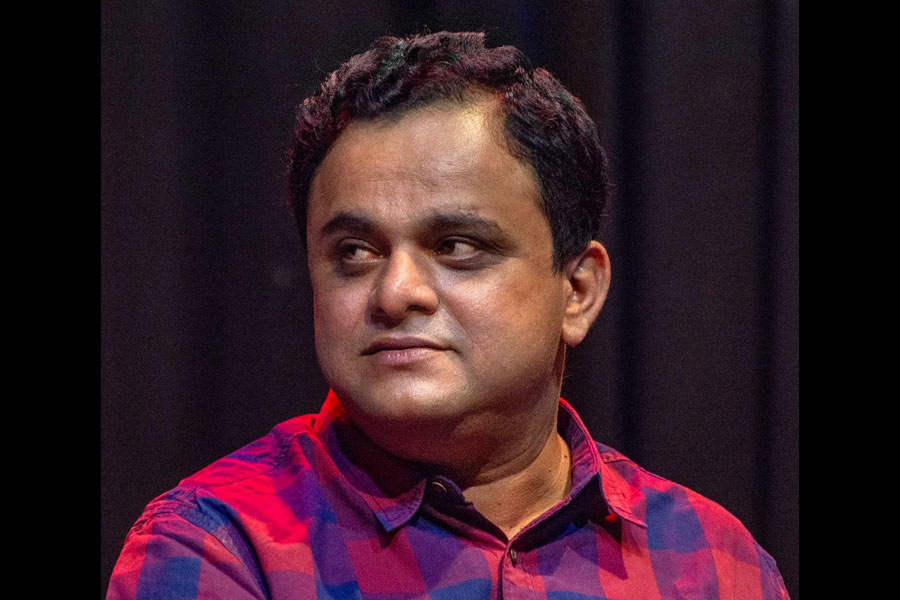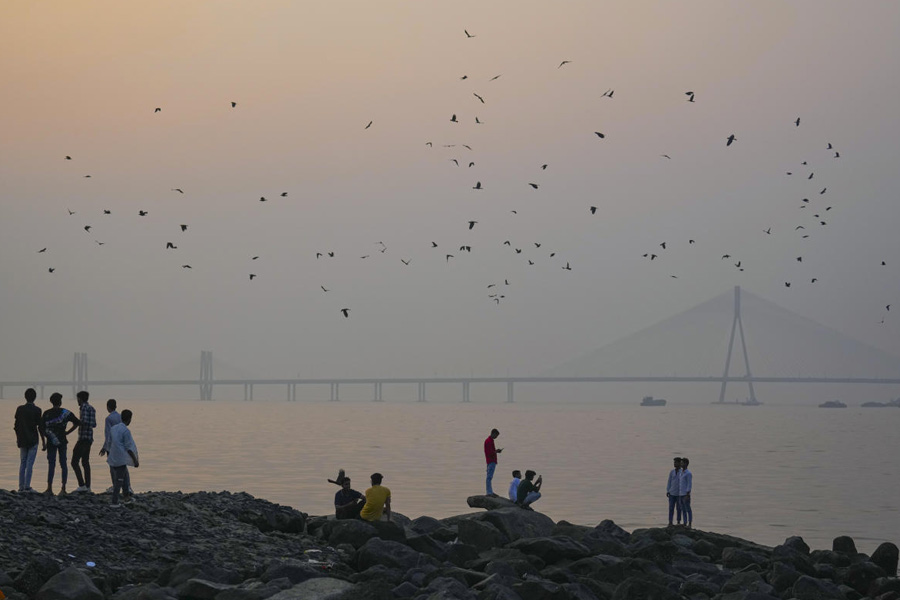The Bengali Association of South Africa (BASA) has revived the tradition of public celebrations of Durga Puja in the country with a four-day event that ended with Devi Boron and Sindoor Khela on Tuesday.
Previously confined to temples built by the local Indian community descended from the first Indians who arrived in 1860 as indentured labourers for the sugar cane farms, BASA hosted the Durga Puja at the Marlboro Community Centre, north of Johannesburg.
One of the highlights that delighted hundreds of locals was the Dhunuchi dance by the ladies, young girls and even a few young boys.
“The Dhunuchi dance is an essential part of Durga Puja as it symbolises prosperity and positivity, emanating from the aromatic incense burnt in the brass or clay incense holder (known as a dhunuchi), which the women waft in graceful movements,” explained BASA President Gourish Chakraborty.
“The origin of BASA lies in the first migrants who came to work in South Africa in the early 1990s when India resumed relations with South Africa following almost 40 years of isolation due to apartheid.
“There were about 30 or 40 families across South Africa who formed the association. I found this out only when I had a TV interview with the national public broadcaster South African Broadcasting Corporation. Many Bengali people who have settled here started calling me,” Chakraborty said.
"As more Bengalis started arriving to work here, we started the Durga Puja in a small way 19 years ago and it has grown exponentially to where we constantly have to find larger venues.
“We got to a stage where we started importing the Murthi of Durga Maa from India every few years, and this has also attracted a lot of local Indian devotees to join us for the celebration each year,” Chakraborty said.
Conceding that funding does become a challenge, Chakraborty said BASA found great support from even the settlers from Bangladesh, formerly part of India.
“We are so fortunate that our celebrations cross all the boundaries of language and religion. Even the shopkeepers, who are mostly Muslims from Bangladesh, have also been supporting us and have been donating towards our projects,” he said.
Chakraborty noted that the other major BASA project annually was a Kavi (Poetry) Night.
“Every year we also celebrate the birthdays of celebrated Bengali literary figures Rabindranath Tagore and Kavi Nazrul Islam, the two most renowned poets of the region. We get adults and children performing plays, recitals and songs related to these two great men. The event is well-supported by locals as well,” he said.
The second wave of migrants from India after over a century has also enhanced the celebration of the Navratri festival in South Africa, local community leaders say.
For nine nights each year, Navaratri is celebrated with fervour at venues across the country by both the Indians descended from the first migrants who arrived from 1860 onwards and the expatriate Indians who began arriving from the 1990s onwards after the advent of democracy under Nelson Mandela.
From 1947, India banned its citizens from dealing with South Africa in any way, while South Africa’s white minority apartheid government stopped immigration from India and even tried to coerce the exiting Indian community to return to their country with paid passes.
This was despite the fact that they were already into a third and fourth generation born in South Africa by then.
But culturally, the religions, customs and traditions that the first settlers brought with them survived in ways that evolved locally. This includes Navaratri, which by the 1980s had become mainly Garba dancing by senior ladies in the Hindu and mainly Gujarati community.
“All this changed as soon as the first young Indians started coming here after Mandela was released from 27 years as a political prisoner and India resumed relations with South Africa,” said Kishore Badal, chairperson of the Hindu Coordinating Council in Lenasia, the sprawling township some 30 kilometres south of Johannesburg.
The apartheid government had forcibly resettled Indians from across the region in Johannesburg.
“These ‘new’ Indians brought with them a renewed impetus for ensuring cultural and religious celebration, including music, dance and language, which also started appealing more to the South African-born youth who were losing all this,” Badal added.
Hitesh Kanjee, who coordinates one of the largest Navaratri festivals in Lenasia at the Lakshminarayan Mandir and adjacent Ramakrishna Hall, said the vibrancy, colour and modern music that the Indian expats use in their celebration have even lured the younger generation to the events run by the expat community.
“So much so that this year we found a lower turnout at our event. Also, where previously most Indians lived in one area, there were large crowds, but now that many people have moved to former white areas all over the city where they were once prohibited, they find it more convenient to join a local Navaratri event,” Kanjee said.
Latching onto the tendency for the expat community to bring out musical groups from Gujarat and Mumbai, a sizeable Indian community in the once all-white suburbs of Johannesburg South brought one such group and drew large crowds at the nightly festivities.
Kanjee also said the Indian expats have familiarised the local community with Indian food.
“In the past, we did not have things like bhel puri and paani puri at our events. Now the food stalls have a wide range of street foods that are popular in India and the locals have started lapping it up at events like Navaratri and public celebrations of Diwali, where a number of stalls selling these foods pop up,” Kanjee said.
On Saturday night, to ensure that supporters did not stay home to watch the crucial World Cup Rugy semifinal between South Africa and England, large screens were set up at some of the Navaratri venues to watch the nail-biting match, with garba sticks flying into the air after the South African squad made it into the final by a single point.
Except for the headline, this story has not been edited by The Telegraph Online staff and has been published from a syndicated feed.










